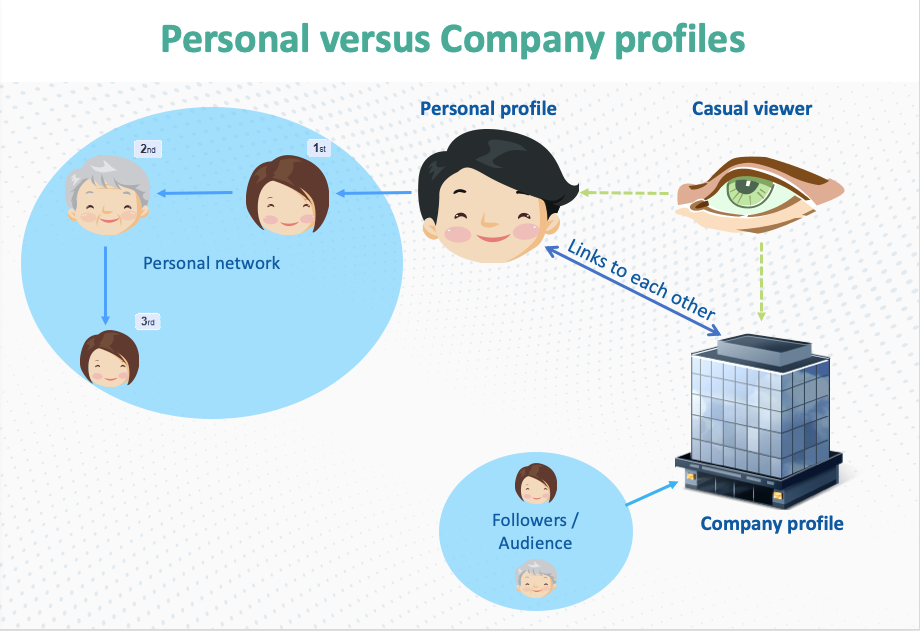— December 17, 2018
This is a question we get asked surprisingly often so we thought we’d clarify the difference between a personal profile and a company profile on LinkedIn.
In a single diagram it works like this …

Personal versus Company profiles
A company profile is … all about the company
What it does, how many staff, what specialities the company has, where it’s based etc, and is a great way of informing existing and potential clients what the business is up to. It can also be a little ‘salesy’ as it is kind of expected but it can also talk about the culture, the business, the results and share useful ‘stuff’ not just the company news.
Everything the company does is shared with the followers of the company (they are the audience) and that equates to all the staff that work there and the people interested enough to hit follow on a company page.
The last research we saw from LinkedIn said that only 10% on average of the personal networks (connections) that the staff were connected to also chose to follow the company. In our perspective that feels about right as a rough guide but this can sometimes be less too.
There is an expectation that companies will be positive, will be company brand centric and will form part of any due diligence check in terms of the business actually doing what the potential employee, acquirer or client thinks they do.
Company profiles on LinkedIn also have a completely different range of functions including the ability to segment the audience of followers so that you can show a selected message to a selected audience. For example, if you have a huge client base in Healthcare you can show anyone from that industry an update which is written for them, or perhaps you have clients in France so you can show them a French language version, but no one that is not in France or Healthcare would see the message.
In summary, a company profile is an important company voice (ideal for companies as you get above a handful of employees), fulfils a hygiene role (so much so that a poor company profile might lose you a client and may not get you a new one) and gives a good central hub of corporate identity and message across the team. However, your status updates will not get the same level of engagement or reach as those from the staff as there is an assumption that the company will say what it always says whereas people are more interested in your views and your voice which has 10 times more impact within LinkedIn for spreading positivity, word of mouth and content.
If you are not utilising your company profile to its full potential why not consider our LinkedIn Company Profile session.
Personal profiles
A personal LinkedIn profile showcases you as an individual, not the company you work for.
Someone looking at your profile should have the same experience as they would get meeting you face to face, and hence it should be as good as you are in real life. Sadly more people now “meet” on line for the first time, rather than meeting face to face.
LinkedIn is a great platform for connecting with existing clients, potential clients and colleagues, and can be used to talk about what you are up to in your business life (not your personal life like Facebook!) and to keep in touch with your real life network.
Unlike a company profile you can also include aspects that help to prove your trust level and credibility using recommendations and to a lesser degree endorsements.
But you do need to ensure your profile is current, up to date and reflects your real life with activity such as status updates (just like you talk to people in real life), your current role and your own personal style and values.
Don’t forget to keep your contact details up to date on your profile so people can reach you easily when they need you!
Summary
The personal and company profiles are inherently linked as they both appear on each other’s profiles (staff on company and company on personal profiles), but form different roles and hence have different responsibilities but a casual viewer on LinkedIn can look at or chose to follow either but they can only connect with a person.
If I had to pick only one? It would be personal profile as these have a significantly different level of impact on the reputation, visibility of you, your message and bottom line results.
Digital & Social Articles on Business 2 Community
(30)